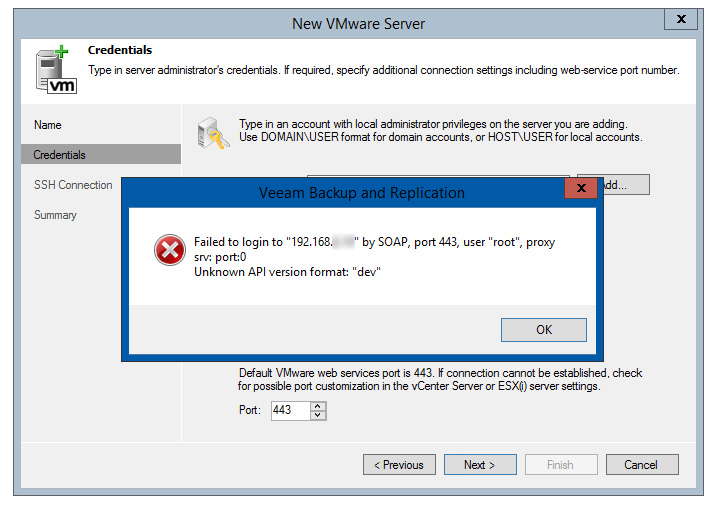
- #VEEAM BACKUP PORTS HOW TO#
- #VEEAM BACKUP PORTS INSTALL#
- #VEEAM BACKUP PORTS DOWNLOAD#
- #VEEAM BACKUP PORTS WINDOWS#
#VEEAM BACKUP PORTS WINDOWS#
Veeam installer service and data mover service on Windows servers. SSH connection to VMware vSphere servers. Some ports that can be changed (I might be missing a few but at least it is a start )ĭuring installation - the Catalog Service port, Backup service port and secure connection port.
#VEEAM BACKUP PORTS HOW TO#
In the last part of the series i’m going to cover how to set up the communication from the Veeam Backup & Replication server to our Splunk Server by using the universal forwarder.All ports are listed here. In this part of the series, I covered the installation of the “Veeam Backup Monitor for Splunk” plugin aswell as the firewall preparation. Test-NetConnection -Port 9997Īs you can see both tests were successful, which means we have a proper connection between our both servers. When using Test-NetConnection utilize the cmdlet with an IP address or a DNS Name to verifiy if the port 9997 is open. If you get an empty prompt, you are connected to your server with the desired port. If you are using telnet, simply use the telnet command with an IP address or DNS name to verify if the port 9997 is open. Either using “telnet” or the “Test-NetConnection” cmdlet through PowerShell. Now that it seems the firewall rule has been successfully added we have two ways to test the connection. Get-NetFirewallRule -DisplayName "Open 9997 for Splunk" With the “Get-NetFirewallRule” cmdlet you are able to recheck if the rule applied successfully and the status is up. netsh advfirewall firewall add rule name="Open 9997 for Splunk" dir=out action=allow protocol=TCP localport=9997 Configuring Windows Firewallįor configuring the Windows Firewall i utilized PowerShell to create a new rule for opening the port 9997. Now that we have configured our CentOS Firewall we need to do the same as outgoing traffic on our Veeam Backup & Replication Windows server. If you want to review your made settings, just utilize firewall-cmd -list-all With the above command you are able to reload the firewall settings. firewall-cmd -zone=public -add-port=9997/tcp -permanent I used the following command to add the port 9997 to the public zone of my CentOS server. In order to achieve that, we have to utilize “firewall-cmd” regarding the CentOS Splunk Server. The aim is to open up “port 9997” from the Windows Veeam Backup & Replication Server to the Splunk Server. For now, we are going to prepare both servers to prevent the firewalls block each other. We will cover the installation and the configuration in the next part of the series. This forwarder sends the data to the Splunk server.
#VEEAM BACKUP PORTS INSTALL#
As my installation is in a homelab i don’t have any firewalls in between those two machines except the turned on Windows Firewall and the CentOS Firewall.įor the communication between our Veeam and Splunk Server we will have to install a so called “Universal forwarder” on our Veeam Backup & Replication server. In order to prepare for setting up the communication between our Veeam Backup & Replication Server and the Splunk Server, we need to ensure, that the firewall between those both servers won’t block any traffic.

This will be covered in the last part of the series. Thats because we didn’t set up any communication between the Veeam Backup & Replication Server and the Splunk Server for now. If you click on the plugin on the left hand side, you will notice, that you can’t see anything until now. If everything went fine you should be able to log in to your server and see the new plugin on the left hand side of your navigation pane. You can simply switch to the binary directory again under “/opt/splunk/bin” and restart your Splunk server.Īfter hitting the above command, your splunk server will shut down and restart again, which should look like this:Īfter restarting, head to your webinterface of your Splunk server and try to log in with your URL. The folder is called “/opt/splunk/etc/apps”.Īfter you have moved the plugin you will need to restart your Splunk server in order to load it. All you have to do is to move the unpacked folder “veeam_backup_monitor” to the “apps” directory of your Splunk installation. The installation of the plugin is really easy. tgz file you will have a folder called “veeam_backup_monitor”. tgz file simply unpack it.Īfter unpacking the. I created a new folder under /tmp/ called “veeam_splunk” where i uploaded the.
#VEEAM BACKUP PORTS DOWNLOAD#
After creating the account you can simply download the plugin on the right hand side.Īfter downloading the.

Therefore you will need to create an account within the splunkbase. Downloading the Pluginįirst of all we need to download the “Veeam Backup Monitor for Splunk” plugin on the splunkbase. This part covers the installation of the “Veeam Backup Monitor for Splunk” plugin and the firewall configuration on the Veeam Backup and Replication server and the Splunk Server for future communication.

Now that we have installed our Splunk server, we need to do some more installation and configuration.


 0 kommentar(er)
0 kommentar(er)
